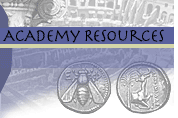 |

I am frequently asked by collectors new to the hobby which books they should acquire to get a good grounding in ancient coins. Building a good numismatic reference library is of prime importance in gaining the maximum enjoyment from your hobby and it is always advantageous to be well informed when entering the coin market as a buyer. Books - especially rare out of print standard works - can also be an excellent investment (frequently better than the coins themselves).
The following recommendations are general works, intended as introductions to their subject (though not always aimed at the novice). Also review the specialized reference works requiring a fuller comprehension of the subject matter.
Modesty forbids me from blowing my own trumpet too loud, but the fact remains that over the years my own books have provided many new collectors with their first exposure to the subject and fired their enthusisasm to pursue it further. Having said that, I should like to recommend the following as providing excellent introductions to the various aspects of ancient numismatics. Do bear in mind that many titles are out of print but are frequently available from dealers specializing in books, such as George Frederick Kolbe, P.O. Drawer 3100, Crestline, CA 92325, ph. (909) 338-6527, fax (909) 338-6980.

Kenneth Jenkins' book "Ancient Greek Coins" provides an excellent introduction to the subject and is superbly illustrated, especially in the original (1972) edition. The revised 1990 edition reflects latest thoughts on chronology but is less visually appealing. Seltman's "Greek Coins, a History of Metallic Currency and Coinage down to the fall of the Hellenistic Kingdoms" is also a very readable account of this complex subject, and although the text is now a little outdated there are 64 plates of good photographic illustrations. Undoubtedly, the ultimate book in this field is the monumental "Greek Coins", with authoritative text by Colin Kraay and superb photographic illustrations (including many enlargements) by the renowned photographer Max Hirmer. Published in 1966, this large format work has been long out of print and is in great demand. In consequence it is very expensive, usually selling for around $500, though if you can afford it this book is well worth the price. Somewhat more specialized are works such as Kraay's "Archaic and Classical Greek Coins" published in 1976, and Otto M┐rkholm's "Early Hellenistic Coinage, from the Accession of Alexander to the Peace of Apamea (336-186 BC)" published in 1991. Both are well illustrated and very readable, as well as being useful works of reference. Although almost 90 years old, Barclay V. Head's encyclopedic "Historia Numorum" remains a magnificent achievement of early 20th century scholarship and as a single-volume work has never been equaled since. It contains such a wealth of information that every collector of Greek coins is strongly advised to acquire a copy for his or her library (reprints are frequently available). A useful source of background information is John Melville Jones' "A Dictionary of Ancient Greek Coins" (1986) which includes topics relating to 'Greek Imperial' coinage.

Roman coinage also has some excellent introductory books. Humphrey Sutherland's "Roman Coins" published in 1974 (in the same series as Jenkins' "Ancient Greek Coins") has, like its companion volume, good text combined with fine quality illustrations, some in full color. Andrew Burnett's "Coinage in the Roman World" is more recent (1987) and concentrates on the subject of interpretation rather than simple description, an aspect of Roman coins which I am personally drawn to and would recommend others to pursue. Robert Carson's "Coins of the Roman Empire" is another high quality production, very much in the tradition of Harold Mattingly's pre-war work "Roman Coins, from the Earliest Times to the Fall of the Western Empire", though incorporating the ideas of modern scholarship. The companion volume to the classic Kraay-Hirmer "Greek Coins" is the Kent-Hirmer "Roman Coins" authored by J.P.C. Kent. Produced on the same lavish scale, fortunately this work can be obtained at somewhat more reasonable cost, usually less than half the price of its Greek counterpart. An excellent and highly useful work in dictionary form is John Melville Jones' "A Dictionary of Ancient Roman Coins" (1990) produced as a companion volume to his work on Greek coinage. A book to which I am personally drawn is Philip Hill's fascinating "The Monuments of Ancient Rome as Coin Types", published in 1989. This aims at identifying as many as possible of the numerous architectural images appearing on the Roman coinage.

Byzantine coins have always been more of a minority interest, though it is a series to which I have always been strongly attracted. Of primary importance is Philip Grierson's "Byzantine Coins" published in 1982. This is by far away the most masterly survey of the subject by the scholar whose name has become synonymous with excellence in numismatic research and publications. Also noteworthy, though not in the same league as Prof. Grierson's work, is Philip Whitting's "Byzantine Coins" published in 1973. This book forms party of the same series as Jenkins' "Ancient Greek Coins" and Sutherland's "Roman Coins" and has the same highly attractive format. In my early days as a professional numismatist, long before the explosion of interest in things Byzantine over recent decades, the only introductory work available on the subject was Hugh Goodacre's "A Handbook of the Coinage of the Byzantine Empire". Originally published before the Second World War, this book reappeared in a revised version in 1957. Although it has little value these days as a numismatic work its main interest lies in the imperial biographies which, as Dennis Kroh comments, are "very fun to read as the historical bits read more like a gossip novel than a reference". Incidentally, Kroh's own work "Ancient Coin Reference Reviews" (1993) is also highly recommended as a useful source of information and comment on many of the publications in the field of Greek, Roman and Byzantine numismatics.
|  |

![]()
![]()




